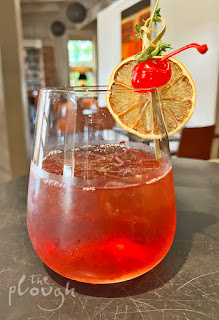Santa's Hat

This week we take a look back at the inclement weather that Myrniong has always experienced, particularly after the deluge we have received over the past few days. During a thunderstorm in April 1907, William Hooton, who eventually took over the licence of the Myrniong Hotel before it was delicenced, had a horse killed by a lightning strike. A couple of years later, two thunderstorms, travelling from different directions, met over the Pentland Hills in March 1909. Almost 30mm of rain fell within 20 minutes, flooding the bare paddocks and filling the dams and creeks that had been bare for months. In January 1944 much-needed rain was delivered by way of heavy thunderstorms which replenished the local creeks, resulting in them running freely again. And what does all this have to do with this week's Cocktail: well, nothing other than today being the first day of Summer, which means Christmas is not far away. I offer you Santa's Hat. SANTA'S HAT 45mL Citrus Vodka 15m...



